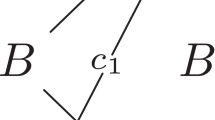Abstract
A multi-equation spatial econometric model is used to explain variations across EU regions in manufacturing productivity growth based on recent theoretical developments in urban economics and economic geography. The paper shows that temporal and spatial parameter homogeneity is an unrealistic assumption, contrary to what is typically assumed in the literature. Constraints are imposed on parameters across time periods and between core and peripheral regions of the EU, with the significant loss of fit providing overwhelming evidence of parameter heterogeneity, although the final model does highlight increasing returns to scale, which is a central feature of contemporary theory.
Similar content being viewed by others
References
Abdel-Rahman H, Fujita M (1990) Product variety, Marshallian externalities, and city sizes. J Region Sci 30:65–183
Anselin L (1988) Spatial econometrics: methods and models. Kluwer, Dordrecht
Brakman S, Garretsen H, van Marrewijk C (2001) An introduction to geographical economics. Cambridge University Press, Cambridge
Ciccone A, Hall R E (1996) Productivity and the density of economic activity. Am Econ Rev 86:54–70
Combes P-P, Lafourcade M (2001) Transportation costs decline and regional inequalities: evidence from France. CEPR DP 2894
Combes P-P, Lafourcade M (2004) Trade costs and regional disparities in a model of economic geography: structural estimations and predictions for France. Unpublished paper available from http://www.enpc.fr/ceras/combes/
Combes P-P, Overman H (2003) The spatial distribution of economic activity in the EU. CEPR DP 3999
Dixit A, Stiglitz J E (1977) Monopolistic competition and optimum product diversity. Am Econ Rev 67:297–308
Fingleton B (2000) Spatial econometrics, economic geography, dynamics and equilibrium: a third way? Environ Plan A 32:1481–1498
Fingleton B (2001a) Equilibrium and economic growth: spatial econometric models and simulations. J Region Sci 41:117–148
Fingleton B (2001b) Theoretical economic geography and spatial econometrics: dynamic perspectives. J Econ Geogr 1:201–225
Fingleton B (2003) Increasing returns: evidence from local wage rates in Great Britain. Oxford Econ Pap 55:716–739
Fingleton B (2005a) Towards applied geographical economics: modelling relative wage rates, incomes and prices for the regions of Great Britain. Appl Econ 37:2417–2428
Fingleton B (2005b) Beyond neoclassical orthodoxy: a view based on the new economic geography and UK regional wage data. Pap Region Sci 84:351–375
Fingleton B (2006) The new economic geography versus urban economics : an evaluation using local wage rates in Great Britain. Oxford Econ Pap 58:501–530
Fingleton B, McCann P (2007) Sinking the iceberg ? On the treatment of transport costs in new economic geography. In: B Fingleton (ed) New directions in economic geography. Edward Elgar, Cheltenham, pp 168–203
Fingleton B, McCombie JSL (1998) Increasing returns and economic growth: Some evidence for manufacturing from the European Union regions. Oxford Econ Pap 50:89–105
Forslid R, Haaland J, Midelfart Knarvik K-H (2002) A U-shaped Europe? A simulation study of industrial location. J Int Econ 57:273–297
Fujita M, Thisse, J-F (1996) Economics of agglomeration. J Jpn Int Econ 10:339–378
Fujita M, Krugman P, Venables AJ (1999) The spatial economy. MIT Press, Cambridge
Head K, Mayer T (2003) The empirics of agglomeration and trade. CEPR DP 3985
Huriot J-M, Thisse J-F (eds) (2000) Economics of cities. Cambridge University Press, Cambridge
Jacobs J (1969) The economy of cities. Jonathan Cape, London
McCann P (2005) Transport costs and new economic geography. J Econ Geogr 5:305–318
Redding S, Venables A J (2004) Economic geography and international inequality. J Int Econ 62:53–82
Rice P, Venables A J (2003) Equilibrium regional disparities: theory and British evidence. Region Stud 37:675–686
Rivera-Batiz F (1988) Increasing returns, monopolistic competition, and agglomeration economies in consumption and production. Region Sci Urban Econ 18:125–153
Author information
Authors and Affiliations
Corresponding author
Appendix
Rights and permissions
About this article
Cite this article
Fingleton, B. A multi-equation spatial econometric model, with application to EU manufacturing productivity growth. J Geograph Syst 9, 119–144 (2007). https://doi.org/10.1007/s10109-006-0038-5
Received:
Accepted:
Published:
Issue Date:
DOI: https://doi.org/10.1007/s10109-006-0038-5




